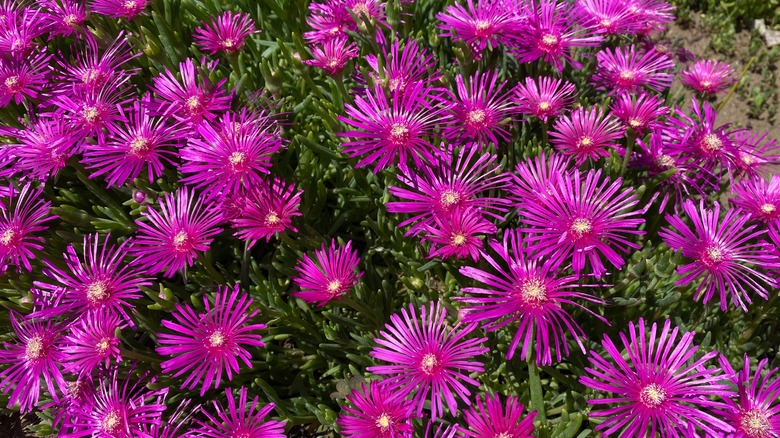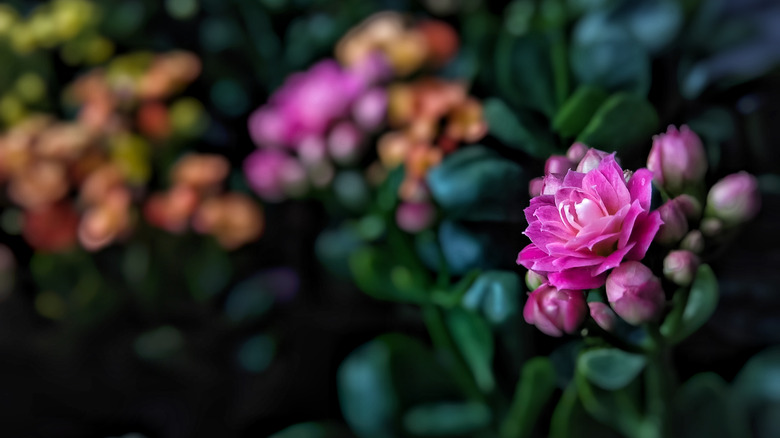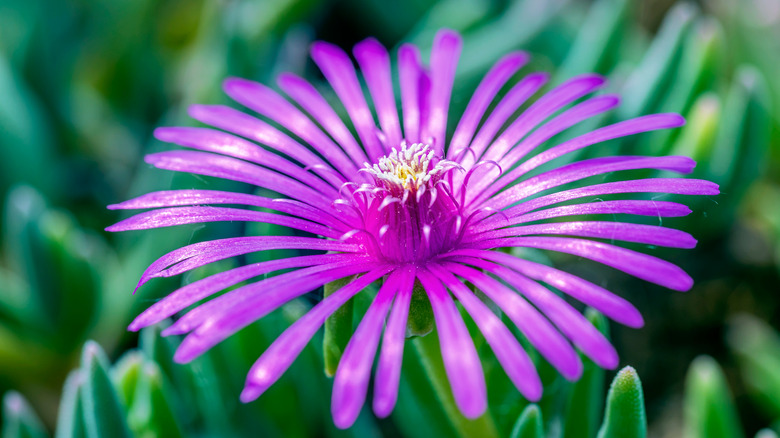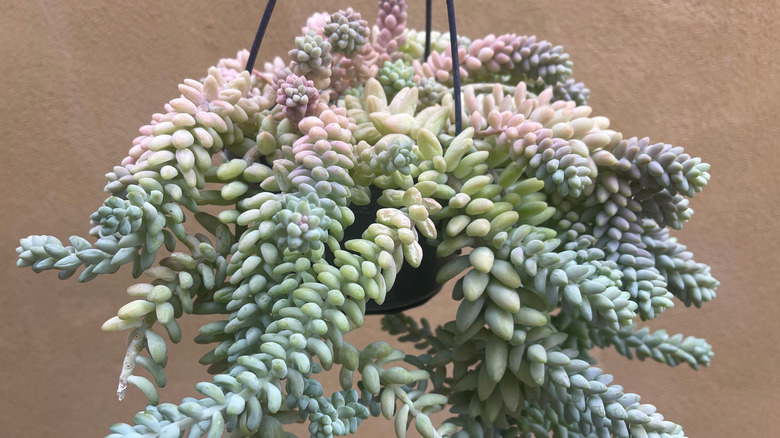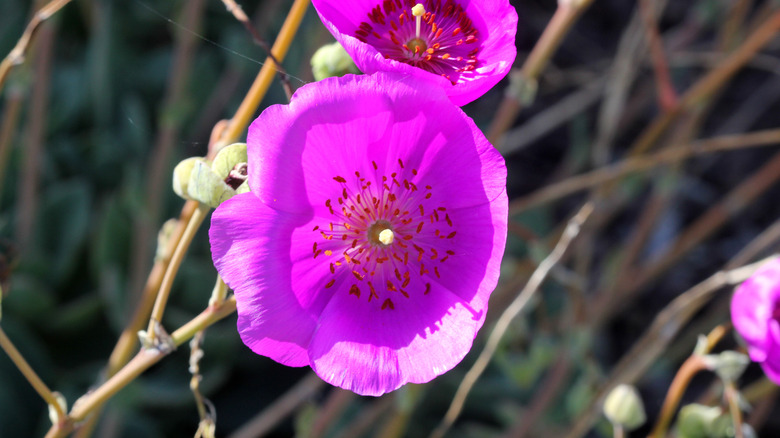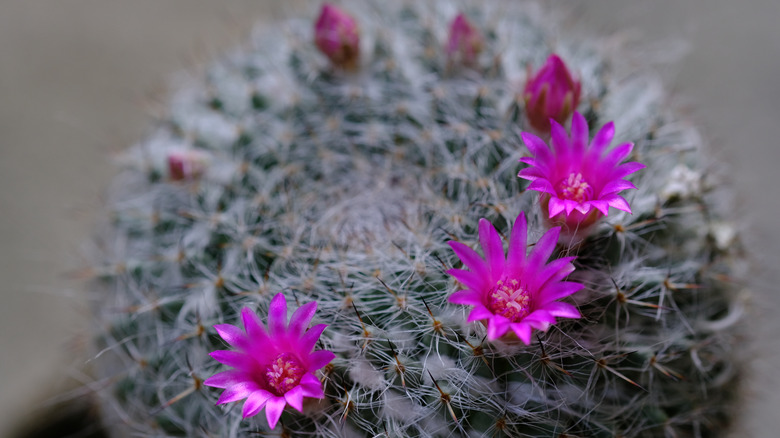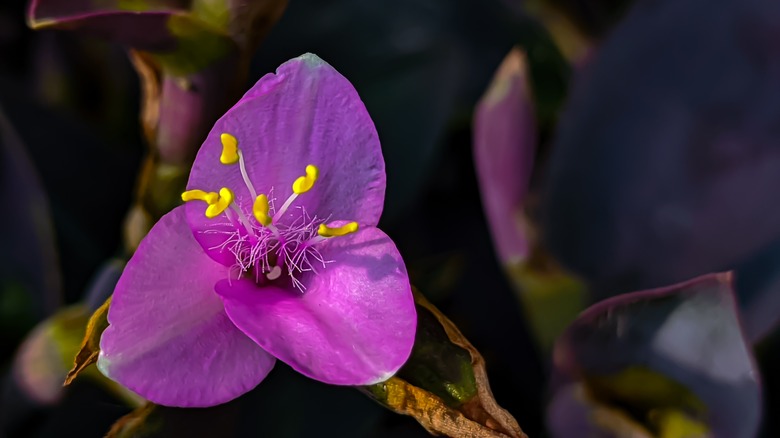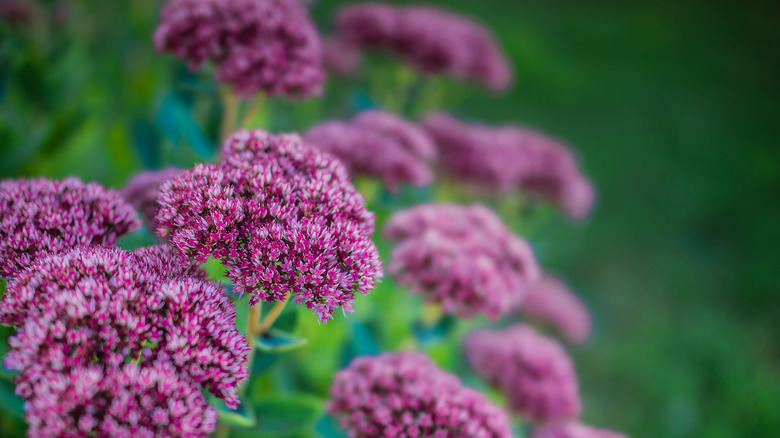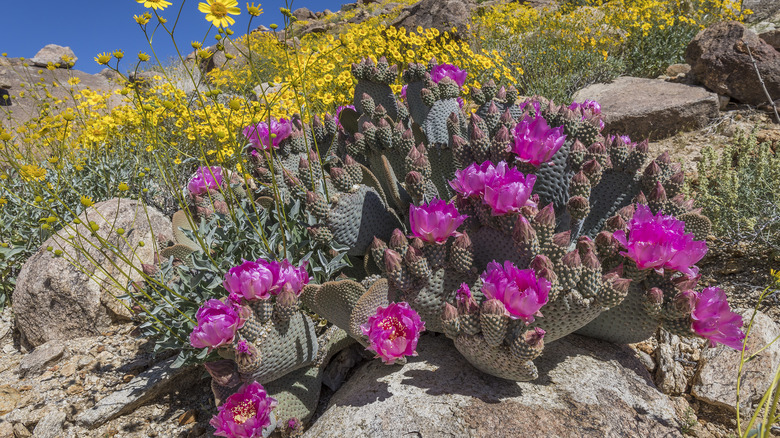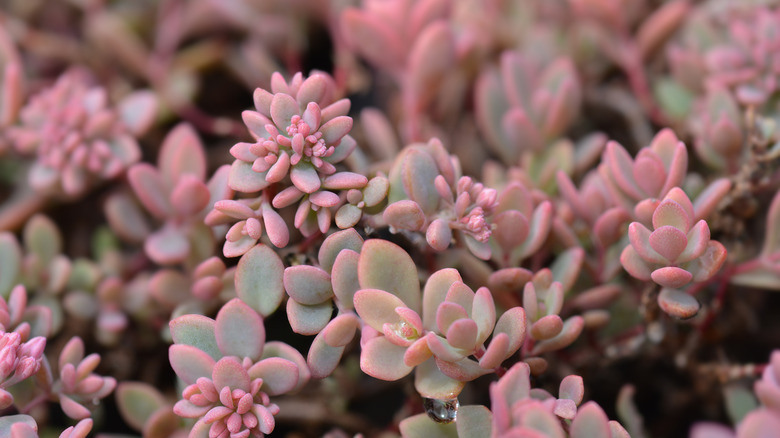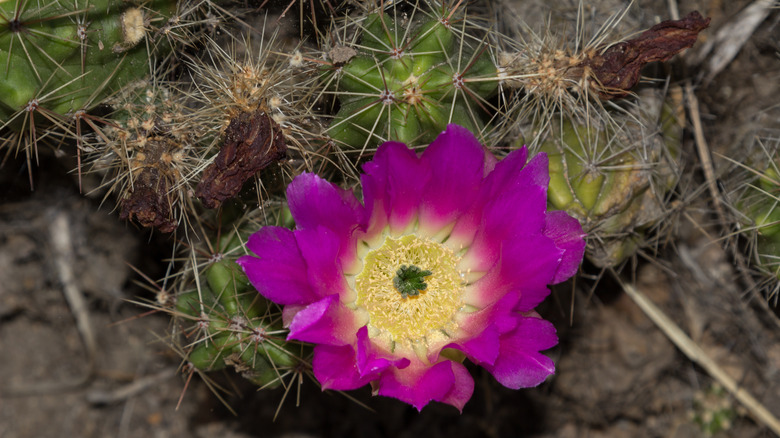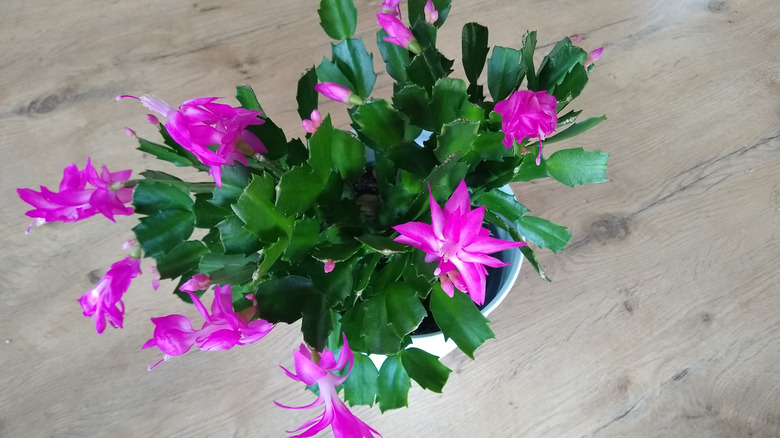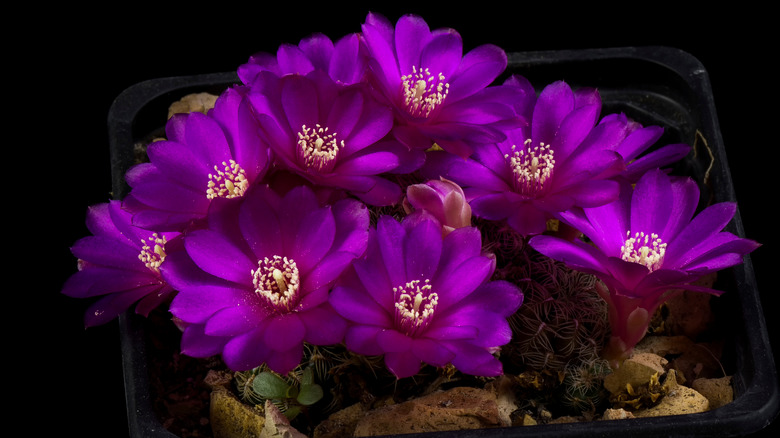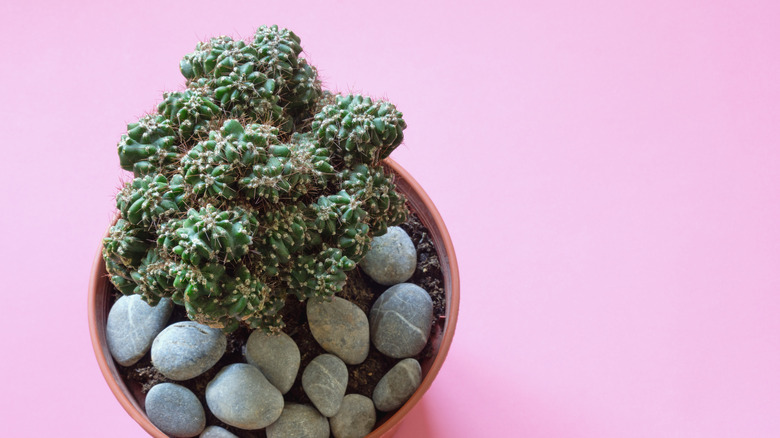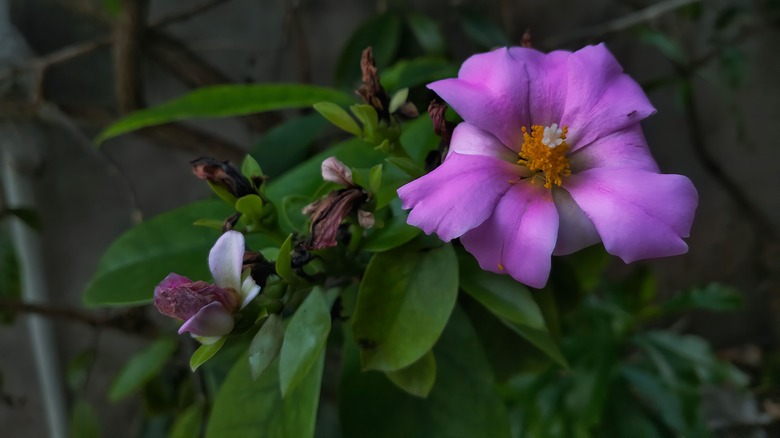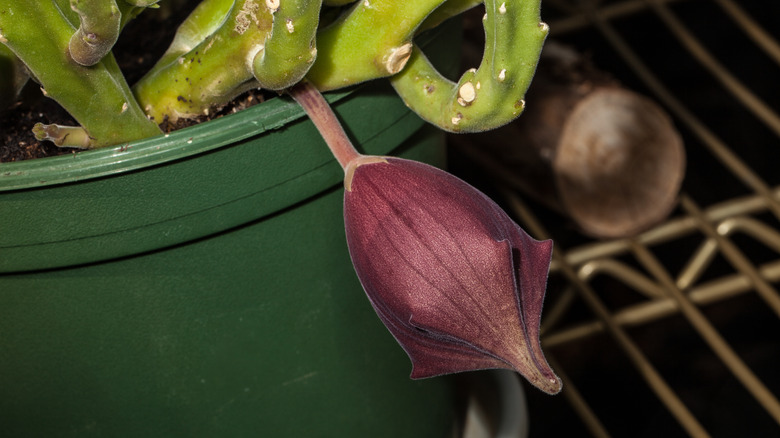15 Succulents That Bloom With Dramatic Purple Flowers
Though many succulents and cacti bloom with incredible flowers, few of them appear purple. For us lovers of purple, our options are severely limited when it comes to purple-blooming plants, especially those of the low-maintenance variety. Among the most popular and best-selling blooming succulents, as listed by Mountain Crest Gardens, are the string of pearls plant, pickle plant, Parodia erubescens, and pink jelly bean, all of which bloom with yellow or white flowers.
Still, there are some options. No matter what climate you live in, you can find these gorgeous cacti and succulents that bloom each year with minimal care. Simply pot your favorite species with some well-draining potting soil and provide it with the right type of sunlight and watering schedule. Before moving it outdoors, however, do check your local USDA hardiness zone to make sure it won't die from exposure to the wrong climate. In this article, we've compiled 15 purple-blooming succulents and cacti that will not disappoint. Take a look at all of these options and consider trying out your preferred plant for an explosion of purple during its blooming season.
1. Kalanchoe
Kalanchoe flowers (Kalanchoe blossfeldiana) are known for their blooming clusters that are available in a range of bright colors, including purple. Clemson Cooperative Extension describes this succulent as a popular houseplant that requires little maintenance. However, you should be mindful to keep it situated in direct sunlight, or else it will suffer.
Bloom Season: Early spring
USDA Growing Zone: 10 to 12
Growing Conditions: Full sun
Soil Type: Well-drained
Size: 8 inches to 1 foot tall
2. Hardy ice plant
The hardy ice plant (Delosperma cooperi) is a pollinator-friendly ground cover succulent that blooms with purple to pink flowers throughout the spring and summer months, as told by High Country Gardens. Like other succulent species, this one prefers full sun conditions. Make sure to plant it in well-draining soil and water it sparingly.
Bloom Season: Spring to summer
USDA Growing Zone: 5 to 9
Growing Conditions: Full sun
Soil Type: Well-draining
Size: 1 to 2 inches tall and 15 to 18 inches wide
3. Burro's tail
Burro's tail (Sedum morganianum) is a common houseplant grown across the United States that can bloom with purple flowers as well. North Carolina State Extension says that the succulent only blossoms for a short time in the summer, but the maroon-purple flowers that appear on the ends of the plant's hanging stems are worth the wait.
Bloom Season: Summer
USDA Growing Zone: 10 to 11
Growing Conditions: Full sun to partial shade
Soil Type: Alkaline and well-draining
Size: 1 to 4 feet tall and wide
4. Redmaids
Redmaids (Calandrinia grandiflora) are beautiful plants native to Chile that show off large, round flowers that only bloom for a single day. San Marcos Growers compares the flowers to that of the rockrose, which is a flowering shrub, not a succulent. You wouldn't confuse the two because the redmaid's thick, fleshy leaves give it away.
Bloom Season: Spring to fall
USDA Growing Zone: 8 to 10
Growing Conditions: Full sun to partial shade
Soil Type: Well-draining
Size: 1 foot tall and 2 to 3 feet wide
5. Old lady cactus
The old lady cactus (Mammillaria hahniana) is a staple in cacti and succulent gardens. This spiky plant is known for its halo of adorable flowers that appear in shades of pink, purple, and red. RHS states that the cactus is best used as a container plant, especially if you don't live in the right climate to grow the old lady plant outdoors.
Bloom Season: Summer
USDA Growing Zone: 9 to 11
Growing Conditions: Full sun
Soil Type: Well-drained loam or sand
Size: 1 foot tall and 8 inches wide
6. Purple heart plant
The purple heart plant (Tradescantia pallida) has thick, fleshy purple foliage and striking pale purple flowers that appear toward the end of summer. This versatile plant is recommended for use in several different ways by the University of Wisconsin-Madison, including in hanging baskets, large containers, or mass plantings in-ground.
Bloom Season: Mid-summer to fall
USDA Growing Zone: 7 to 10
Growing Conditions: Full sun
Soil Type: Well-draining
Size: 1 foot tall but spreads widely
7. Evergreen orpine
Evergreen orpine (Hylotelephium anacampseros) is a unique plant that doesn't look like a succulent at first glance. Described as an herbaceous perennial, the evergreen orpine shows off clusters of purple flowers and smooth, rounded leaves. North Carolina State Extension notes that the plant has some sweeter common names including the herb of friendship, love restorer, and the love-restoring stonecrop.
Bloom Season: Summer
USDA Growing Zone: 4 to 9
Growing Conditions: Full sun to partial shade
Soil Type: Well-draining
Size: 6 to 10 inches tall and 8 to 12 inches wide
8. Beavertail prickly pear
Beavertail prickly pear cacti (Opuntia basilaris) are related to the popular eastern prickly pear cactus, and they look somewhat similar. While the eastern relative bears large yellow blooms, this one has purple flowers that may be larger than 3 inches wide, as stated by the Lady Bird Johnson Wildflower Center.
Bloom Season: Spring and summer
USDA Growing Zone: 8 to 10
Growing Conditions: Full sun
Soil Type: Gravelly and well-draining
Size: Up to 3 feet tall
9. Azure stonecrop
The azure stonecrop (Hylotelephium cyaneum), which is a part of the same genus as the evergreen orpine, can be recognized by its purple to green stems and foliage as well as its star-shaped purple blossoms. As told by RHS, this stonecrop species is mat-forming and perfect for a rock garden. Thankfully, it can survive in somewhat cold weather so you can grow it outdoors even if you live in one of the colder states.
Bloom Season: Summer to fall
USDA Growing Zone: 4 to 9
Growing Conditions: Full sun
Soil Type: Well-draining
Size: Up to 4 inches tall
10. Strawberry hedgehog cactus
The strawberry hedgehog cactus (Echinocereus engelmannii) is among the most prolific purple-blooming cacti. This specific plant is characterized by 3-inch-wide flowers and cylindrical stems littered with long, golden spines, as described by the Lady Bird Johnson Wildflower Center. Keep in mind that the strawberry hedgehog cactus can be dangerous to grow around children and pets.
Bloom Season: Spring
USDA Growing Zone: 5 to 9
Growing Conditions: Well-draining
Soil Type: Full sun
Size: Up to 10 inches tall
11. Christmas cactus
Christmas cacti (Schlumbergera russelliana) bloom in some shades of yellow, red, pink, purple, and white. Their easy care requirements and unusual bloom season have made them a very popular houseplant, especially during the holiday season. Sometimes, you may hear this species also being called the Thanksgiving cactus, Easter cactus, or shrimp cactus, as per North Carolina State Extension.
Bloom Season: Fall and winter
USDA Growing Zone: 9 to 11
Growing Conditions: Full sun
Soil Type: Moist and well-draining
Size: 6 inches to 1 foot tall
12. Sulcorebutia cactus
The Sulcorebutia cactus (Sulcorebutia albissima), or the yellow crown cactus, is a round plant that shows off radial spines that make it look like a spiked crown. In the summer, as stated by RHS, this cactus produces tubular purple flowers that emerge from its sides. If you're lucky, the Sulcorebutia cactus may produce more flowers around its body that look like a halo.
Bloom Season: Summer
USDA Growing Zone: 9 to 11
Growing Conditions: Full sun
Soil Type: Well-drained loam or sand
Size: 4 inches tall
13. Ming thing
The ming thing (Cereus forbesii monstrose) is a strange-looking succulent with natural mutant growth, as per North Carolina State Extension. The plant develops short, lobed stems that grow atop one another. From these stems, black spines as well as flowers are produced. The flowers are purple to white, and they only bloom at nighttime.
Bloom Season: Summer to fall
USDA Growing Zone: 9 to 11
Growing Conditions: Partial shade
Soil Type: Well-draining
Size: Up to 1 foot tall
14. Rose cactus
Rose cacti (Pereskia grandifolia) are warm-weather plants, native to Brazil, that feature deciduous foliage and large, light purple flowers with long petals. While they are extremely ornamental, they are also useful in other ways. The leaves of the rose cactus are edible and even considered medicinal, as explained by Missouri Botanical Garden.
Bloom Season: Summer
USDA Growing Zone: 10 to 12
Growing Conditions: Full sun to partial shade
Soil Type: Rich and well-draining
Size: 6 to 16 feet tall and wide
15. Black bells
Black bells (Stapelia leendertziae) are a species of flowering succulents in the dogbane family, which is known for the Zulu giant, star jasmine, and porcelain flowers. Like these species, the black bells plant shows off gorgeous blooms that appear in the summer. North Carolina State Extension notes that the star-shaped flowers produced by the succulent are pollinated by flies.
Bloom Season: Summer and fall
USDA Growing Zone: 9 to 11
Growing Conditions: Full sun to partial shade
Soil Type: Well-draining
Size: 6 inches tall
